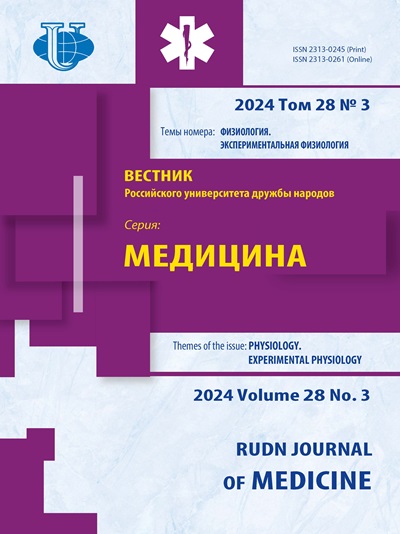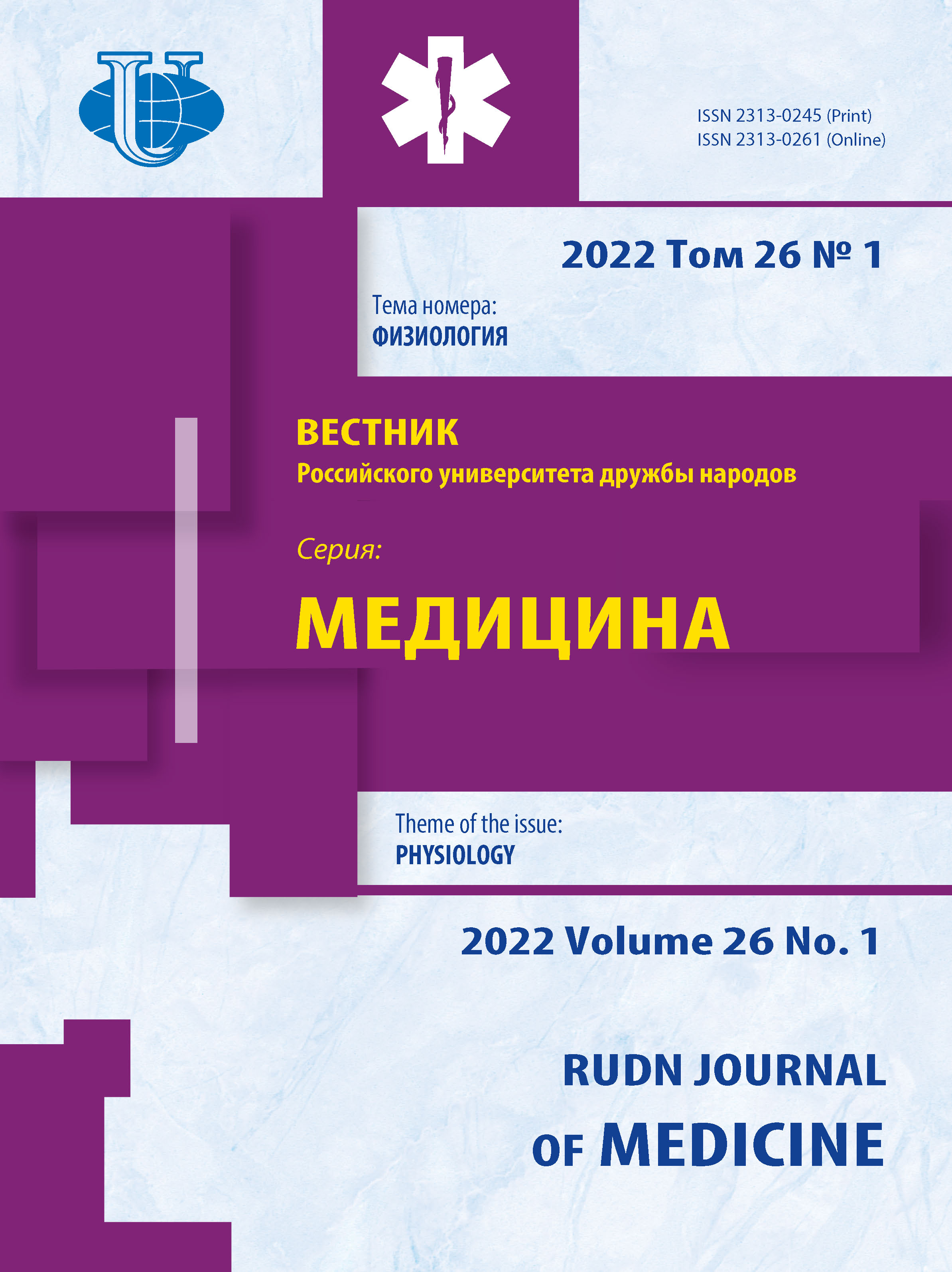Trace elements content in the hair of patients at the maxillofacial surgery department
- Authors: Gedulyanov M.T.1, Kiyaeva E.V.2
-
Affiliations:
- Central Research Institute of Dentistry and Maxillofacial Surgery
- Orenburg State University
- Issue: Vol 26, No 1 (2022): PHYSIOLOGY
- Pages: 42-50
- Section: Physiology
- URL: https://journals.rudn.ru/medicine/article/view/30535
- DOI: https://doi.org/10.22363/2313-0245-2022-26-1-42-50
Cite item
Full Text
Abstract
Relevance. The urgency of the problem of traumatism is constantly increasing, which is associated with an increase in road accidents, an increase in the number of interpersonal conflicts, the availability of firearms and cold steel weapon, etc. In addition, the proportion of victims with injuries of the maxillofacial region in a state of alcoholic intoxication is constantly growing. The aim of the study is to conduct a comparative analysis of trace elements in hospitalized patients with maxillofacial trauma, intoxicated, acute traumatic stress and the study of the effect of trauma on the balance of trace elements in patients of the Department of Maxillofacial Surgery with various alcohol history. Materials and Methods. The study involved 30 male patients of the department of maxillofacial surgery of the Moscow «city clinical F.I. Inozemtseva hospital located in the city of Moscow. All patients were joined to the department for trauma of the maxillofacial tract and were divided into two groups: 15 of them regularly took alcohol and were in a state of alcoholic intoxication at the time of injury (group 1), 15 - without alcohol history (comparison group 2). All patients carried a general clinical blood test, a biochemical blood test, and the content of essential and conditionally essential elements in the hair were also determined. Results and Discussion. As a result, significant differences were revealed in the content of micro elements between the groups of patients: the content of copper (p = 0.013) and zinc (p = 0.000) in the hair examined of the first group was 1.4 lower than in the comparison group 2. The manganese content (p = 0.05), on the contrary, was also increased by 1.4 times in the hair of group 1 patients. Besides, leukocytosis was detected in the blood in patients with a history of alcohol and an increase in AST levels. Conclusion. The study showed an increase in the content of manganese and a decrease in the content of selenium, zinc and copper in the hair of patients with an alcoholic history. Diselementosis was accompanied by a significant increase in aspartate aminotransferase activity, as well as leukocytosis and lymphocytosis. Such an imbalance of chemical elements, together with a changes of peripheral blood and an increase in the activity of ASaT, can be reflected on the period the timing and peculiarities of the course of the reparative process.
Keywords
About the authors
Marat T. Gedulyanov
Central Research Institute of Dentistry and Maxillofacial Surgery
Author for correspondence.
Email: lambrador2@gmail.com
ORCID iD: 0000-0002-6819-2067
Moscow, Russian Federation
Elena V. Kiyaeva
Orenburg State University
Email: lambrador2@gmail.com
ORCID iD: 0000-0002-6476-7839
Orenburg, Russian Federation
References
- Ajsuvakova OP, Tinkov AA, Aschner M, Rocha JBT, Michalke B, Skalnaya MG, Skalny AV, Butnariu M, Dadar M, Sarac I, Aaseth J, Bjørklund G. Sulfhydryl groups as targets of mercury toxicity. Coordination Chemistry Reviews. 2020;417:213343. https://doi. org/10.1016/j.ccr.2020.213343
- Karganov MY, Medvedeva YS. Аlteration of iron (fe), copper (cu), zinc (zn), and manganese (mn) tissue levels and speciation in rats with desferioxamine-induced iron defi. BioMetals. 2021;149:111973.
- Tinkov AA, Voskresenskaya ON, Aaseth J, Tsatsakis A, Aschner M, Paoliello MMB, Martins AC, Mazilina AN, Skalny AV, Santamaria A, Notova SV, Lee E, Bowman AB. Molecular targets of manganese-induced neurotoxicity: a five-year update. International Journal of Molecular Sciences. 2021;22:9:4646. doi: 10.3390/ ijms22094646
- Steinberg A. Prone restraint cardiac arrest: a comprehensive review of the scientific literature and an explanation of the physiology. Med Sci Law. 2021;1-12:47. doi: 10.1177/0025802420988370
- Chandrasekaran R, Lacy DB. The role of toxins in Clostridium difficile infection. FEMS microbiology reviews. 2019;41:723-750.
- Garey KW. A randomized, double-blind, placebo-controlled, single and multiple ascending dose Phase 1 study to determine the safety, pharmacokinetics and food and faecal microbiome effects of ibezapolstat administered orally to healthy subjects. Antimicrob Chemother. 2020;75:3635-3643.
- Barrio P, Gual A. Patient-centered care interventions for the management of alcohol use disorders: a systematic review of randomized controlled trials. Patient Prefer. Adher. 2016;10:1823-1845.
- Barrio P, Wurst FM, Gual A. New Alcohol Biomarkers. New challenges. Alcohol Alcohol. 2018; 53:762-763.
- Frazier HN, Maimaiti S, Anderson KL, Brewer LD, Gant JC, Porter NM, Thibault O. Calciums role as nuanced modulator of cellular physiology in the brain. Biochem. Biophys. Res. Commun. 2017; 483:981-987.
- Grochowski C, Blicharska E, Baj J, Mierzwin´ska A, Brzozowska K, Forma A, Maciejewski R. Serum iron, magnesium, copper and manganese levels in alcoholism: a systematic review. Molecules. 2019;24:1361.
- Maini RN, Taylor PC. Anti-cytokine therapy for rheumatoid arthritis. Annu Rev Med. 2000;51:207-229. doi: 10.1146/annurev. med.51.1.207
- Ogawa Y, Kinoshita M, Shimada S, Kawamura T. Zinc and skin disorders. Nutrients. 2018;10:199.
- Palmer BF, Clegg DJ, Taylor SI, Weir MR. Diabetic ketoacidosis, sodium glucose transporter-2 inhibitors and the kidney. J. Diabetes Complicat. 2016;30:1162-1166.
- Vincent JB, Lukaski HC. Chromium. Adv. Nutr. 2018;9:505-506.
- Bogaevskaya OYu, Sokhov ST. Risks of injection pain relief in dental treatment. RUDN Journal of Medicine. 2020;24:1:61-68. doi: 10.22363/2313-0245-2020-24-1-61-68 (In Russian).
- Durnova NA, Sheremetyeva AS, Karetnikova AYu. Analysis of the effect of caffeine and dioxidine on the biochemical parameters of the blood of mice. RUDN Journal of Medicine. 2021;25:1:73-79. doi: 10.22363/2313-0245-2021-25-1-73-79 (In Russian).
- Emelyanova AS, Simonyan LA, Stepura EE. Analysis of the electrocardiogram of students with different levels of motor activity. RUDN Journal of Medicine. 2021;25:2:127-135. doi: 10.22363/23130245-2021-25-2-127-135 (In Russian).
- Merkulova MA, Lapkin MM. Physiological cost as a factor determining the effectiveness of human activity in the reproduction of visual images. RUDN Journal of Medicine. 2020;24:3:253-261. doi: 10.22363/2313-0245-2020-24-3-253-26 (In Russian).
- Sudakov KV. Information principle in physiology: analysis from the standpoint of the general theory of functional systems. Advances in physiological sciences. 1995;26:4:3-27. (In Russian).
- Chests DV, Putintsev VA, Shekera VV, Bogomolov DV, Romanova OL. The use of modern forensic medical methods of postmortem diagnostics of blood loss. RUDN Journal of Medicine 2021;25:2:154-161. doi: 10.22363/2313-0245-2021-25-2-154-161 (In Russian).
- Chuchkova NN, Smetanina MV, Kormilina NV, Kanunnikova OM, Pazinenko KA. The cellular composition of the thymus in drug-related magnesium deficiency. RUDN Journal of Medicine. 2020;24:1:85-92. doi: 10.22363/2313-0245-2020-24-185-92 (In Russian).
















